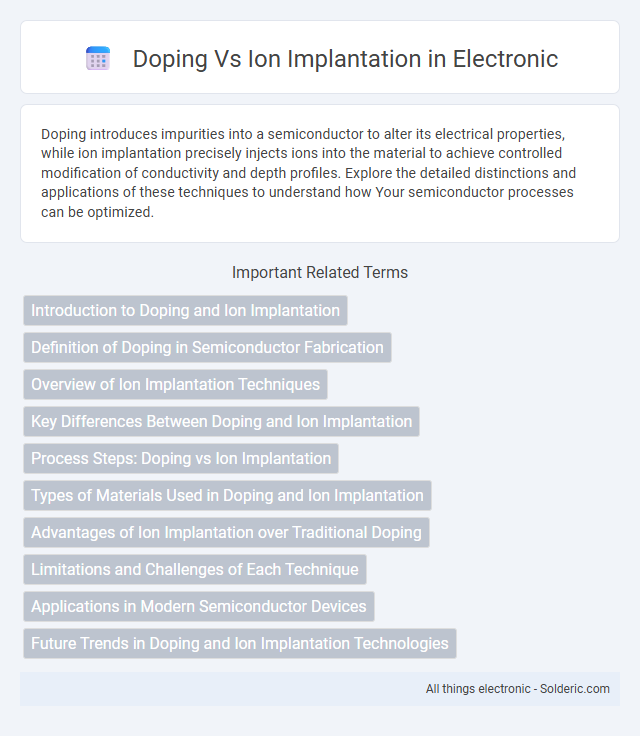Doping introduces impurities into a semiconductor to alter its electrical properties, while ion implantation precisely injects ions into the material to achieve controlled modification of conductivity and depth profiles. Explore the detailed distinctions and applications of these techniques to understand how Your semiconductor processes can be optimized.
Comparison Table
| Aspect | Doping | Ion Implantation |
|---|---|---|
| Definition | Introduction of impurities into a semiconductor to change electrical properties. | Precise insertion of ions into a substrate using an ion beam for controlled doping. |
| Method | Diffusion or thermal process. | Ion beam acceleration and implantation. |
| Control | Less precise; depth and concentration depend on temperature and time. | High precision in dose, depth, and location. |
| Damage to Substrate | Minimal structural damage. | May cause lattice damage, requiring annealing. |
| Applications | Used in traditional semiconductor manufacturing for bulk doping. | Used in advanced semiconductor fabrication, CMOS technology. |
| Cost | Generally lower cost. | Higher cost due to equipment and process complexity. |
Introduction to Doping and Ion Implantation
Doping introduces specific impurities into semiconductor materials to alter electrical properties, enhancing conductivity and device performance. Ion implantation precisely injects dopant ions into the substrate at controlled energies, allowing for accurate depth and concentration profiles. Your semiconductor device optimization depends on selecting the appropriate doping method to balance process complexity, material damage, and electrical characteristics.
Definition of Doping in Semiconductor Fabrication
Doping in semiconductor fabrication involves intentionally introducing impurity atoms into a pure semiconductor to modify its electrical properties, thereby enhancing conductivity. Ion implantation is a precise doping technique where ions of the dopant are accelerated and embedded into the semiconductor substrate at controlled depths and concentrations. This method allows for accurate adjustment of carrier concentration profiles essential for device performance in integrated circuits.
Overview of Ion Implantation Techniques
Ion implantation involves accelerating ions of a dopant element into a semiconductor substrate to precisely control the distribution and concentration of dopants in semiconductor devices. Techniques vary based on ion energy, dose, and beam current, with common methods including high-energy implantation for deep profiles and low-energy implantation for shallow junctions. This process enables enhanced dopant activation and reduced diffusion compared to traditional doping methods, making it critical for advanced semiconductor fabrication.
Key Differences Between Doping and Ion Implantation
Doping introduces impurities into semiconductors by diffusing dopant atoms during high-temperature processing, while ion implantation injects ions directly into the substrate using accelerated ion beams, enabling precise control over impurity depth and concentration. Ion implantation offers ultra-shallow junction formation and minimal lattice damage due to low thermal budgets, contrasting with doping's thermal diffusion that can cause broader profiles and unintended dopant spread. Key differences include implantation's superior accuracy, reduced thermal budget, and versatility for complex semiconductor architectures compared to traditional doping methods.
Process Steps: Doping vs Ion Implantation
Doping involves introducing impurities into a semiconductor wafer using diffusion or gas-phase methods, where dopant atoms diffuse into the substrate at high temperatures. Ion implantation precisely bombards the substrate with high-energy dopant ions, embedding them at controlled depths without requiring elevated temperatures during the process. Post-implantation annealing activates the dopants and repairs crystal damage, ensuring electrical properties similar to those achieved by traditional doping techniques.
Types of Materials Used in Doping and Ion Implantation
Doping typically involves introducing impurities such as boron, phosphorus, or arsenic into semiconductor materials like silicon or germanium to modify electrical properties. Ion implantation uses accelerated ions of these dopants precisely embedded into substrates, enabling control over the depth and concentration profiles in materials including silicon carbide and gallium arsenide. Both methods are essential for tailoring electronic and optoelectronic device performance through selective modification of semiconductor materials.
Advantages of Ion Implantation over Traditional Doping
Ion implantation offers precise control over dopant concentration and depth profiles, enabling enhanced semiconductor device performance and uniformity. This method reduces crystal damage and contamination compared to traditional diffusion, resulting in higher device reliability and yields. Ion implantation also allows for low-temperature processing, minimizing thermal budget and preserving device integrity during fabrication.
Limitations and Challenges of Each Technique
Doping faces limitations such as diffusion control difficulties and less precision in achieving ultra-shallow profiles, while ion implantation challenges include lattice damage and the need for post-implantation annealing to repair defects. Both methods encounter issues with maintaining uniformity and scalability in advanced semiconductor devices, impacting device performance and yield. Understanding these constraints helps optimize your semiconductor fabrication process for improved electrical characteristics and reliability.
Applications in Modern Semiconductor Devices
Doping and ion implantation are essential techniques in modern semiconductor device fabrication, enhancing electrical properties by introducing controlled impurities into silicon wafers. Doping, often achieved through diffusion or ion implantation, creates p-type or n-type regions critical for transistor operation, while ion implantation offers precise control over dopant concentration and depth, enabling advanced device scaling and performance. Applications include CMOS technology, where ion implantation defines source/drain regions with high uniformity, and power devices that require tailored doping profiles for optimized conductivity and breakdown voltage.
Future Trends in Doping and Ion Implantation Technologies
Future trends in doping and ion implantation technologies emphasize precision control at the nanoscale, enabling advanced semiconductor device fabrication. Emerging methods like plasma doping and laser annealing improve dopant activation and reduce lattice damage, enhancing device performance and efficiency. Your semiconductor applications will benefit from these innovations, supporting higher transistor densities and lower power consumption in next-generation electronics.
Doping vs Ion implantation Infographic

 solderic.com
solderic.com